Cessna A-37 Dragonfly
| A-37 Dragonfly | |
|---|---|
 | |
| An OA-37B Dragonfly aircraft from the Illinois Air National Guard during Exercise GRANADERO I, 14 May 1984 | |
| Role | Light ground-attack aircraft |
| National origin | United States |
| Manufacturer | Cessna |
| First flight | 1963 from T-37 Trainer |
| Status | Limited service in South American Air Forces |
| Primary users | United States Air Force (historical) South Vietnamese Air Force (historical) Chilean Air Force (historical) Peruvian Air Force |
| Produced | 1963–1975 |
| Number built | 577[1] |
| Developed from | Cessna T-37 Tweet |
The Cessna A-37 Dragonfly, or Super Tweet, is an American light attack aircraft developed from the T-37 Tweet basic trainer in the 1960s and 1970s by Cessna of Wichita, Kansas. The A-37 was introduced during the Vietnam War and remained in peacetime service afterward.
Design and development
The growing American military involvement in Vietnam in the early 1960s led to strong interest in counter-insurgency (COIN) aircraft. In late 1962, the U.S. Air Force's Special Air Warfare Center at Eglin Air Force Base's Hurlburt Field in Florida evaluated two T-37Cs for the role.
The Air Force found the T-37 promising, but wanted an improved version of the aircraft that could carry a much larger payload, and had much greater endurance and better short-field performance. This meant a heavier aircraft with more powerful engines. In 1963, the Air Force awarded a contract to Cessna for two prototype YAT-37D aircraft: T-37s with modifications that included:
- Stronger wings.
- Three stores pylons on each wing.
- Larger wingtip fuel tanks of 360 litre (95 US gallons) capacity.
- A General Electric GAU-2B/A 7.62 mm "Minigun" Gatling-style machine gun, with a rate of fire of 3,000 rounds/minute and 1,500 rounds of ammunition. The weapon was fitted in the right side of the aircraft's nose behind a large, convenient access panel. A gunsight and gun camera were also fitted.
- Better avionics for battlefield communications, navigation, and targeting.
- Tougher landing gear for rough-field operation.
These changes meant a drastic increase in aircraft weight and the aircraft now had to carry a significant payload as well. Cessna, therefore, doubled the engine power by replacing the two Continental J-69 engines with General Electric J85-J2/5 turbojet engines with 2,400 lbf (10.7 kN) thrust each.
The first YAT-37D flew in October 1964, followed a year later by the second prototype. The second prototype had four stores pylons under each wing, rather than three, and the first prototype was upgraded to this configuration as well.
Test results were good, but USAF interest in counter-insurgency (COIN) aircraft had faded for the moment. The program went into limbo for a time, with the second prototype "put out to pasture" at the National Museum of the United States Air Force at Wright-Patterson Air Force Base in Ohio.
The war in Southeast Asia, however, continued to escalate. Losses of Douglas A-1 Skyraider close-support aircraft in USAF, USN and South Vietnamese service proved greater than anticipated and USAF interest in COIN aircraft was revived. The YAT-37D seemed like a promising candidate for the job, but the Air Force felt that the only way to be sure was to evaluate the aircraft in combat.
As a result, the USAF issued a contract to Cessna for a pre-production batch of 39 YAT-37Ds, with a few minor changes relative to the prototypes, to be rebuilt from existing T-37Bs. These aircraft were initially designated AT-37D, but the designation was quickly changed to A-37A. The second prototype YAT-37D was pulled out of the Air Force Museum and upgraded to A-37A standards as part of the test program.
The A-37A had a gross takeoff weight of 12,000 lb (5,440 kg), of which 2,700 lb (1230 kg) was ordnance. The A-37A retained the dual controls of its T-37B ancestor, allowing it to be used as an operational trainer.
In combat "forward air control (FAC)" operations, the second seat was occupied by an observer. Only one crewman normally flew in the aircraft for close support missions, permitting a slight increase in ordnance.
Operational history
Vietnam War
In August 1967, 25 A-37As were sent to Vietnam under the "Combat Dragon" evaluation program, and flew from Bien Hoa Air Base on USAF "air commando" missions, including close air support, helicopter escort, FAC, and night interdiction. Combat loads included high-explosive bombs, cluster munition dispensers, unguided rocket packs, napalm tanks, and the SUU-11/A Minigun pod. For most missions, the aircraft also carried two additional external fuel tanks on the inner stores pylons.
During this period, the A-37As flew thousands of sorties. None were lost to enemy fire, although two were wrecked in landing accidents. The A-37A was formally named the "Dragonfly", but most pilots called it the "Super Tweet". The Combat Dragon program was successful, but unsurprisingly the combat evaluation revealed some of the deficiencies of the A-37A. The most noticeable problem was that the aircraft lacked range and endurance. Other concerns were heavy control response during attack runs (the flight controls were not power-boosted) and the vulnerability of the aircraft's non-redundant flight control system.
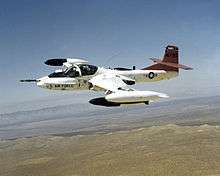
The USAF signed a contract with Cessna in early 1967 for an improved Super Tweet, designated the "A-37B". The initial order was for 57 aircraft, but this was quickly increased to 127. The A-37Bs were primarily intended to be supplied to the South Vietnamese Air Force (VNAF) as replacements for their Skyraiders. The A-37B prototype was rolled out in September 1967, with deliveries to the South Vietnamese beginning in 1968.
The A-37Bs were all newly built airframes. These were stronger than those of the A-37A, capable of pulling 6 g instead of 5, and were built to have a longer fatigue life of 4,000 hours. Field experience would demonstrate that 7,000 hours between overhauls could be tolerated.
The A-37B weighed almost twice as much as the T-37C. A remarkable fraction of the loaded weight, 5,800 lb (2,600 kg), could be external stores. In practice, the A-37B usually operated with at least two and sometimes four underwing fuel tanks to improve combat endurance.
To get this increased weight off the ground, the A-37B was fitted with General Electric J85-GE-17A engines, providing 2,850 lbf (12.7 kN) thrust each. These engines were canted slightly outward and downward to improve single-engine handling. Air commando pilots in Vietnam operating the A-37A had found single-engine cruise an effective means of improving their flight endurance.
Modifications were made to control surfaces to improve handling. To improve aircraft and crew survivability, the A-37B was fitted with redundant elevator control runs that were placed as far apart as possible. The ejection seats were armored, the cockpit was lined with nylon flak curtains, and foam-filled self-sealing fuel tanks were installed.
The A-37 excelled at close air support. Its straight wings allowed it to engage targets 100 miles per hour slower than swept-wing fighters. The slower speed improved bombing accuracy, enabling pilots to achieve an average accuracy of 45 feet (13.7 m).[2]

The A-37B added a refueling probe to the nose, leading to pipes wrapped around the lower lip of the canopy, for probe-and-drogue aerial refueling. This was an unusual fit for USAF aircraft, which traditionally are configured for boom refueling. Other improvements included updated avionics, a redesigned instrument panel to make the aircraft easier to fly from either seat, an automatic engine inlet de-icing system, and revised landing gear. Like its predecessors, the A-37B was not pressurized.
The A-37 required a relatively low amount of maintenance compared to contemporary fighters—only two hours of maintenance for each hour of flight time. This was partially due to multiple access panels in strategic locations.[3]
The 20 mm GPU-2/A and AMD 30 mm cannon pods were tested with favorable results on the A-37B,[4] but reports indicate that such pods were either seldom or never used in operation.
Post-Vietnam era
A total of 577 A-37Bs were built, with 254 delivered to the South Vietnamese Air Force. At war's end, the A-37 had flown over 160,000 combat sorties with only 22 USAF losses. Approximately 187 A-37Bs were in South Vietnamese service when the country fell. Ninety-two were recovered by the US, while the other 95 were later used by the Communist Vietnamese in missions over Cambodia and during the China conflict in 1979. These "renegade" aircraft were phased out of service in the late 1970s or early 1980s, in all probability due to lack of spares. Some of the aircraft were shipped to Vietnam's then-Communist allies such as Czechoslovakia, Poland, the Soviet Union and East Germany. Others were sold to private foreign owners. Six examples of the A-37B became property of American warbird fans, while four A-37Bs are now privately owned in Australia and New Zealand.
After the war, the USAF passed their A-37Bs from the USAF Tactical Air Command (TAC) to TAC-gained units in the Air National Guard and Air Force Reserve. In the early 1980s these aircraft were assigned to the FAC (Forward Air Control) role and given the designation OA-37B. The OA-37Bs were eventually phased out in the 1980s and 1990s and replaced in the FAC mission by the much more formidable Fairchild Republic A-10 Thunderbolt II in Air Force, Air National Guard and Air Force Reserve service.
OA-37s from the 24th Composite Wing's (later 24th Wing's) 24th Tactical Air Support Squadron (24 TASS) also saw service during Operation Just Cause[5]
Salvadoran Civil War
A-37Bs were used extensively by the Salvadoran Air Force during the Salvadoran Civil War, supplied by the United States in 1983 as a replacement for the Salvadoran Air Force's Dassault Ouragans, several of which had been destroyed on the ground by the FMLN. A-37Bs were used to bomb rebel bases, columns, towns, provided close air support, and flew interdiction missions. A total of 21 A-37Bs and 9 OA-37Bs were supplied during the war, one of which lost a pilot to a Dragunov sniper rifle on November 18, 1989 and another that was shot down by an SA-7 missile on November 23, 1990.[6]
Nine A-37s remained in operational condition by the end of the war.[7]
Other Latin American countries
The A-37B was also exported to Latin America, mostly during the 1970s. It was well suited to their needs because of its simplicity, low cost, and effectiveness for insurgent warfare. Most of the A-37Bs exported south had the refueling probe shortened to act as a single-point ground refueling probe, or deleted completely.
The Guatemalan Air Force flew the A-37 in extensive counter-insurgency operations throughout the 1970s-1990s, losing one aircraft in action in 1985.[8] It has also been widely used for counter-narcotics operations.[9]
On 23 March 2009, Embraer announced that it had reached agreement with the Ecuadorian air force to supply 24 turboprop-powered Embraer EMB 314 Super Tucanos, to replace Ecuador’s aging fleet of Vietnam-era Cessna A-37 Dragonfly strike aircraft.[10]
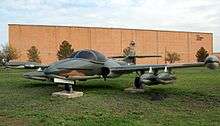
Variants
- YAT-37D
- Two former T-37C trainer prototypes converted for counter-insurgency operations with two J-85-GE engines and six underwing pylons as prototypes for the A-37 series, redesignated YA-37A.
- YA-37A
- Two YAT-37D prototypes redesignated.
- A-37A
- (Cessna Model 318D) T-37B rebuilt with two J-85-GE-5 engines, a 7.62 mm Minigun in nose and eight underwing stores pylons, 39 conversions.
- A-37B
- (Cessna Model 318E) Production version with two J-85-GE-17A engines, provision for inflight refuelling, increased fuel capacity and strengthened airframe, 577 built.
- OA-37B
- The OA-37B Dragonfly was an armed observation aircraft developed during the Vietnam War.
Operators
Current
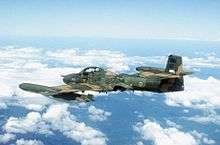
_Lofting.jpg)
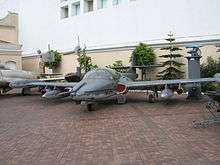
- Colombian Air Force received 32 aircraft – 13 are currently in service. They have been modified to carry GBU-12 Paveway II LGBs.[11]
- El Salvador Air Force received 15 aircraft – nine are currently in service, 10 more on order from Chile.[12]
- Guatemalan Air Force received 13 aircraft – two remain in service.[13]
- Honduran Air Force received 17 aircraft – only 10 remain operational plus 2 in reserve.
- Peruvian Air Force received 53 aircraft – only 10 remain operational. Peru has recently acquired 8 A-37Bs donated by South Korea.[14][15]
- Uruguayan Air Force received 11 aircraft – 3 currently in service.[16]
Former
- Chilean Air Force received 44 aircraft – Retired by the end of 2009, the last two planes in flight were flown back to Santiago-El Bosque AFB on May 27, 2010.[17]
- South Korean Air Force – First introduced in October 1976, the A-37 was replaced by the T-50 Golden Eagle. It also served with the ROKAF Black Eagles aerobatic team, until retired after the Seoul Air Show in 2007.
- Royal Thai Air Force - 16 received in the 1970s, with two more received in the 1980s.[18]
Aircraft on display
Chile
- A-37B FACh 629 is on display at Chile's National Aviation Museum in Santiago.[19]
Colombia
Thailand
- A-37B is on display at the Royal Thai Air Force Museum in Don Mueang, Bangkok.[21]
New Zealand
- A-37B is on display at the Classic Flyers Museum in Mount Maunganui; one of the two has been restored to flying condition [22]
Poland
- A-37B is on display at the Polish Aviation Museum in Kraków donated by Vietnam People's Air Force in 1978 with 2 F-5 (1 F-5A and 1 F-5E) for aeronautical re-engineering projects.[23]
United States
- YA-37A, AF Ser No. 62-5951 is on display at the National Museum of the United States Air Force at Wright-Patterson Air Force Base in Dayton, Ohio. This aircraft, one of two YAT-37Ds, was retired to the museum in December 1964. In August 1966 it was recalled to active service for final testing of the A-37 design. The aircraft was retired to the museum for a second time in July 1970 as the YA-37A.
- GYA-37A is on display at Sheppard Air Force Base in Wichita Falls, Texas
- A-37A, AF Ser. No. 67-14525 is on display at the Museum of Aviation at Robins Air Force Base in Warner Robins, Georgia
- NA-37B is on display at Edwards Air Force Base in Rosamond, California
- A-37B(OA), AF Ser. No. 70-1293 is on display at Hurlburt Field Memorial Air Park in Mary Esther, Florida
- A-37B, AF Ser. No. 71-0826 is on display at the Wings of Eagles Discovery Center in Horseheads, New York
- A-37B is on display at the Planes of Fame Air Museum in Chino, California
- A-37B is on display at The 69th Battalion Special Operations Group in Denver, Colorado
- A-37B, AF Ser. No. 67-14790 is on display at the Lackland Static Airplane Display at Lackland Air Force Base in San Antonio, Texas[24]
Uruguay
- A-37B is on display at the Air Museum Uruguayan Air Force "Museo Aeronáutico" next to Carrasco Airport.
Vietnam
- A-37B, AF Ser. No. 67-14529 is on display at the Vietnam People's Air Force Museum, Hanoi[25]
- A-37B, AF Ser. No. 70-1285 is on display at the Ho Chi Minh City Museum in Ho Chi Minh City, Vietnam.
- A-37B is on display at the War Remnants Museum (Ho Chi Minh City)
- A-37B is on display at the Vietnam People's Air Force Museum, Ho Chi Minh City
- A-37B USAF Ser No. 68-10793 is on static display at the Zone 5 Military Museum, Danang. This is one of the aircraft that was captured by the North Vietnamese and used in the Bombing of Tan Son Nhut Air Base
- A-37B is on display in the Vinh Long Museum, in Vinh Long.
Specifications (A-37B Dragonfly)
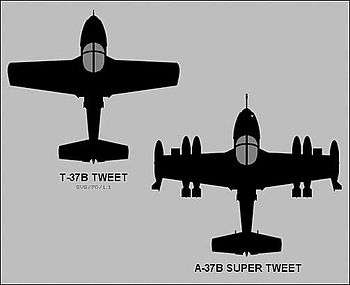
Data from The Encyclopedia of Modern Warplanes[1] and What-When-How[26]
General characteristics
- Crew: 1
- Length: 28 ft 3.4 in (8.62 m)
- Wingspan: 35 ft 10.3 in (10.93 m (including tip tanks))
- Height: 8 ft 10.3 in (2.70 m)
- Wing area: 183.9 ft² (17.09 m²)
- Empty weight: 6,211 lb (2,817 kg)
- Loaded weight: 11,994 lb (5,440 kg)
- Max. takeoff weight: 14,000 lb (6,350 kg)
- Powerplant: 2 × General Electric J85-GE-17A turbojet, 2,850 lbf (12.7 kN) each
Performance
- Maximum speed: 507 mph (440 kn, 816 km/h) at 16,000 ft
- Cruise speed: 489 mph (425 kn, 787 km/h) at 25,000 ft
- Stall speed: 113 mph (98 kn, 182 km/h)
- Range: 920 mi (800 nmi, 1,480 km)
- Combat radius: 460 mi (400 nmi, 740 km) with 4,100 lb warload
- Service ceiling: 41,765 ft (12,730 m)
- Rate of climb: 6,990 ft/min (35.5 m/s)
- Wing loading: 65 lb/ft² (318 kg/m²)
- Thrust/weight: 0.47
Armament
- Guns: 1× .308 in (7.62 mm) GAU-2B/A minigun (mounted in nose)
- Hardpoints: 8 under-wing with a capacity of 1,230 kg
- Gun pods: SUU-11/A (1× 7.62 mm M134 minigun), GPU-2/A (1× 20 mm M197 cannon), 30 mm DEFA cannon
- Rockets: four pods, each with seven 70 mm/2.75-inch rockets (Mk 4/Mk 40 FFAR rockets in a LAU-32/A, LAU-59, or LAU-68 launcher) or (Mk 66/WAFAR rockets in a LAU-131 launcher)
- Missiles: AIM-9 Sidewinder
- Bombs: 500 lb (241 kg) Mk.82 (×8), SUU-14 bomblet dispenser
- Other: Napalm tanks, SUU-25/A Flare Dispenser
See also
- Related development
- Aircraft of comparable role, configuration and era
- Related lists
References
Notes
- 1 2 Gunston, Bill. The Encyclopedia of Modern Warplanes. New York: Blitz Editions, 1995. ISBN 1-85605-290-7
- ↑ Joiner 2009, p. 45.
- ↑ Joiner 2009, p. 46.
- ↑ "Seek Gun - AMD 420 30mm and GPU-2/A 20mm Gun Pod Test." dtic.mil. Retrieved: 14 November 2011.
- ↑ "OPERATION JUST CAUSE: XVIII Airborne Corps and Joint Task Force South". History.army.mil. Retrieved 2012-09-08.
- ↑ "Salvadore". Ejection-history.org.uk. Retrieved 2013-11-27.
- ↑ Cooper, Tom. "El Salvador, 1980–1992". ACIG.org. Retrieved 30 January 2013.
- ↑ Overall, 2004, pp. 12–23.
- ↑ "Drug-Busting Operations Air-to-Air Victories." acig.org, 1 September 2003. Retrieved: 11 January 2011.
- ↑ "Ecuador finalises big Super Tucano order". Flight Global, 24 March 2009. Retrieved 28 December 2011.
- ↑ "Bombas inteligentes EGBU-12 "Paveway II" son adaptadas con éxito a los aviones A-37B Dragonfly de la Fuerza Aérea Colombiana ~ WebInfomil". Webinfomil.com. 2009-08-27. Retrieved 2013-11-27.
- ↑ El-Salvador; AF receives ex-Chilean "Dragonflies" – Dmilt.com, 26 April 2014
- ↑ "A-37B Dragonfly in service." FAG, January 2007. Retrieved: 11 January 2011.
- ↑ "A-37B Dragonfly in service ." FAP, April 2009. Retrieved: 17 January 2011.
- ↑ "Ministro de Defensa recibirá este jueves ocho aviones donados por Corea" (in Spanish). Andina, 3 January 2010. Retrieved: 17 January 2011.
- ↑ EFE (6 February 2014). "Ecuador le regaló a Uruguay repuestos para aviones". El Observador. Retrieved 6 February 2014.
- ↑ "Últimos 2 Aviones A-37 Dragonfly Dejaon Magallens." Archived June 5, 2010, at the Wayback Machine. fach.cl. Retrieved: 11 January 2011.
- ↑ Pocock 1986, p. 115.
- ↑ Romero, Álvero. "66° Aniversario del MNAE." modocharlie.com. Retrieved: 11 January 2011.
- ↑ "Parque Aeronáutico>" (in Portuguese) MAECO Colombian Air and Space Museum. Retrieved: 14 November 2011.
- ↑ "Building 3: Aircraft used in anti-Communism campaign." Royal Thai Air Force Museum. Retrieved: 17 January 2011.
- ↑ "A-37B." Classic Flyers Museum. Retrieved: 17 January 2011. Archived February 5, 2009, at the Wayback Machine.
- ↑ "A-37B." muzeumlotnictwa.pl. Retrieved: 17 January 2011.
- ↑ "Aircraft 67-14790 Data". Airport-Data.com. Airport-Data.com. Retrieved 23 June 2015.
- ↑ Hunt, Julian. "Picture of the Cessna A-37A Dragonfly (318D) aircraft". Airliners.net. Demand Media, Inc. Retrieved 23 June 2015.
- ↑ "Aircraft (Military Weapons)". what-when-how.com. Retrieved 13 July 2015.
Bibliography
- Joiner, Stephen. "Super Tweet". Air & Space, Volume 24, Issue 6, December 2009/January 2010, pp. 42–49.
- Overall, Mario E. "Combat Dragons Guatemala's Cessna A-37s". Air Enthusiast, No. 111, May/June 2004, pp. 12–23.
- Pocock, Chris. "Thailand Hones its Air Forces". Air International, Vol. 31, No. 3, September 1986. pp. 113–121, 168. ISSN 0306-5634.
The initial version of this article was based on a public domain article from Greg Goebel's Vectorsite.
External links
| Wikimedia Commons has media related to Cessna A-37 Dragonfly. |